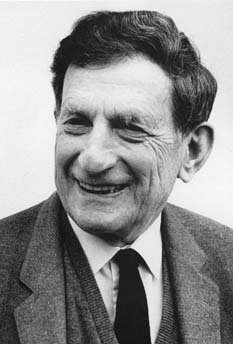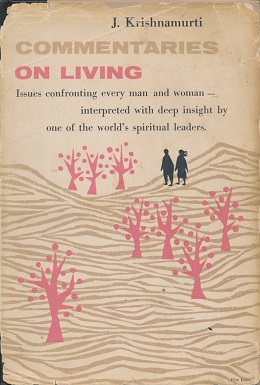
Jiddu Krishnamurti was an Indian philosopher, speaker, writer, and spiritual figure. Adopted by members of the Theosophical tradition as a child, he was raised to fill the advanced role of World Teacher, but in adulthood he rejected this mantle and distanced himself from the related religious movement. He spent the rest of his life speaking to groups and individuals around the world; many of these talks have been published. He also wrote many books, among them The First and Last Freedom (1954) and Commentaries on Living (1956–60). His last public talk was in January 1986, a month before his death at his home in Ojai, California.

David Joseph Bohm was an American–Brazilian–British scientist who has been described as one of the most significant theoretical physicists of the 20th century and who contributed unorthodox ideas to quantum theory, neuropsychology and the philosophy of mind. Among his many contributions to physics is his causal and deterministic interpretation of quantum theory known as De Broglie–Bohm theory.

Tricycle: The Buddhist Review is an independent, nonsectarian Buddhist quarterly that publishes Buddhist teachings, practices, and critique. Based in New York City, the magazine has been recognized for its willingness to challenge established ideas within Buddhist communities and beyond.
Besant Hill School of Happy Valley, formerly the Happy Valley School, is an American private, coeducational boarding school and day school in Ojai, California. Notable subjects are environmental science and sustainability program coupled with a working garden/farm on campus. The school has approximately 100 students and about 35 faculty and staff, all of whom live on or near campus. There were 13 states and 22 countries represented in the 2017–2018 student body.

Radha Burnier was born in Adyar, India. She was president of the Theosophical Society Adyar from 1980 until her death in 2013. She was General Secretary of the Indian Section of the Society between 1960 and 1978, and was previously an actress in Indian films and Jean Renoir's The River.

Edith Penelope Mary Lutyens was a British author who is principally known for her biographical works on the philosopher Jiddu Krishnamurti.

Krishnamurti's Notebook is a diary of 20th-century Indian philosopher Jiddu Krishnamurti (1895–1986). Written during 1961–62, it has been noted for poetic and penetrating descriptions of nature, but is best known for its first hand accounts of persistent, unusual physical experiences and states of consciousness. It has been called "a remarkable mystical document" in press reports, while an authorized Krishnamurti biographer described it as containing "the whole essence" of his philosophy. Reputedly, it was not intended for publication; the manuscript also became entangled in copyright and custody disputes. The work – one of the very few books Krishnamurti wrote himself – was eventually published in 1976 over objections of Krishnamurti associates. An expanded edition with additional material was published in 2003; it includes previously unpublished diary entries from 1962.

The First and Last Freedom is a book by 20th-century Indian philosopher Jiddu Krishnamurti (1895–1986). Originally published in 1954 with a comprehensive foreword by Aldous Huxley, it was instrumental in broadening Krishnamurti's audience and exposing his ideas. It was one of the first Krishnamurti titles in the world of mainstream, commercial publishing, where its success helped establish him as a viable author. The book also established a format frequently used in later Krishnamurti publications, in which he presents his ideas on various interrelated issues, followed by discussions with one or more participants. As of 2022 several editions of the work had been published, in print and digital media.

Commentaries on Living: From the notebooks of J. Krishnamurti is a series of books by Jiddu Krishnamurti. It consists of 3 volumes, originally published in 1956, 1958 and 1960.

At the Feet of the Master is a book attributed to Jiddu Krishnamurti (1895–1986), authored when he was 14 years old. Written under the name Alcyone, it was first published in 1910. The work was closely related to the World Teacher Project, a contemporary messianic endeavor launched by the Theosophical Society. The book is considered a spiritual classic and was still in print in 2012. By that time it had been published in dozens of editions and had been translated in many languages; by 2004 early editions were in the public domain. Throughout its publication history the work has also generated controversy, regarding the author's identity.

Krishnamurti's Journal, republished as The Beauty of Life: Krishnamurti's Journal is a diary of 20th-century Indian philosopher Jiddu Krishnamurti (1895–1986). Originally published in print in 1982, it was republished under the new title in an extended edition in 2023. The diary, a handwritten journal that eschews the first person, is composed of entries dated in 1973, 1975 and 1981. The entries touch on favorite Krishnamurti topics like meditation, the dangerous effects of identification and of conditioned thinking, and the need for radical individual psychological reset. The diary is also known for poetic and nuanced descriptions of nature, and of nature's relationship with human consciousness. The published work is considered one of the very few books Krishnamurti wrote himself.
Rosalind Edith Rajagopal was a long-time director of the Happy Valley School in Ojai, California. She co-founded the school in 1946 with Indian philosopher Jiddu Krishnamurti, Italian literary critic Guido Ferrando, and English author Aldous Huxley.
The Order of the Star in the East (OSE) was an international organisation based at Benares (Varanasi), India, from 1911 to 1927. It was established by the leadership of the Theosophical Society at Adyar, Madras (Chennai) to prepare the world for the arrival of a reputed messianic entity, the World Teacher or Maitreya. The OSE acquired members worldwide as it expanded in many countries; a third of its diverse membership c. 1926 was unaffiliated with the Theosophical Society. The precursor of the OSE was the Order of the Rising Sun and the successor was the Order of the Star. The precursor organisation was formed after leading Theosophists discovered a likely candidate for the new messiah in the then–adolescent Jiddu Krishnamurti (1895–1986), a South Indian Brahmin who was installed as Head of the Order. Almost two decades later Krishnamurti rejected the messianic role, repudiated the Order's mission, and in 1929 disbanded the OSE's successor. The founding and activities of these organisations, as well as the largely unexpected dissolution of the OSE's successor, attracted widespread media attention and public interest. They also led to crises in the Theosophical Society and to schisms in Theosophy. Krishnamurti's later multi-decade career as a notable independent philosopher has been a factor in evaluations of the OSE and its mission.
Choiceless awareness is posited in philosophy, psychology, and spirituality to be the state of unpremeditated, complete awareness of the present without preference, effort, or compulsion. The term was popularized in mid-20th century by Indian philosopher Jiddu Krishnamurti; the concept is a central theme in his philosophy. Similar or related concepts had been previously developed in several religious or spiritual traditions. The term, or others like it, has also been used to describe traditional and contemporary meditation practices, both secular and religious. By the early 21st century,choiceless awareness as a concept or term had appeared in a variety of fields, including neuroscience, therapy, and sociology, as well as in art. However, Krishnamurti's approach to the subject was unique, and differs from both prior and later notions.
Oak Grove School is a private, co-educational, day and boarding school in Ojai, California, United States. It was established in 1975 by Jiddu Krishnamurti and is part of the Krishnamurti Foundation of America.

In Theosophy, Maitreya or Lord Maitreya is an advanced spiritual entity and high-ranking member of a reputed hidden spiritual hierarchy, the Masters of the Ancient Wisdom. According to Theosophical doctrine, one of the hierarchy's functions is to oversee the evolution of humankind; in concert with this function Maitreya is said to hold the "Office of the World Teacher". Theosophical texts posit that the purpose of this Office is to facilitate the transfer of knowledge about the true constitution and workings of Existence to humankind. Humanity is thereby assisted on its presumed cyclical, but ever progressive, evolutionary path. Reputedly, one way the knowledge transfer is accomplished is by Maitreya occasionally manifesting or incarnating in the physical realm; the manifested entity then assumes the role of World Teacher of Humankind.

Jiddu Krishnamurti or J. Krishnamurti, was a writer and speaker on philosophical and spiritual issues including psychological revolution, the nature of the mind, meditation, human relationships, and bringing about positive social change. He came to early prominence thanks to claims, made on his behalf, that he was to be a Messiah. As a young man he repudiated these claims and declared himself unbound by any tradition or philosophy. He spent the rest of his life presenting a uniquely expressed philosophy of life around the world in talks, discussions, and writings.

Krishnamurti to Himself, subtitled His Last Journal, is a book based on a spoken diary of 20th-century Indian philosopher Jiddu Krishnamurti (1895–1986). It discusses psychological, social and spiritual issues he addressed throughout his long career, and like previous diaries includes observations of nature remarked for their originality and nuance; it is however unique in being the only one of his works in this format. Originally recorded in 1983–84, it was first published in print in 1987.

Liam O'Gallagher was an avant-garde sound artist, painter and teacher whose San Francisco studio became an early gathering place for Beat writers and poets in the 1950s. He was integral to the creation of foundations and centers for human growth, including Feathered Pipe Ranch, The Ojai Foundation and the Beatrice Wood Center for the Arts.












